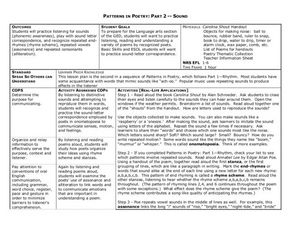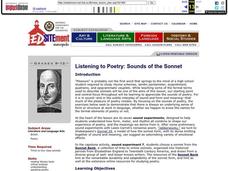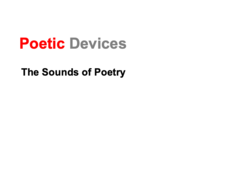Curated OER
Poetry: Using Prosodic Devices
Learners examine poetry examples in free verse focusing on their prosodic elements. After critiquing works by several authors, they write their own poems utilizing such devices as alliteration, repetition, rhyme, and stanzas.
Curated OER
Splish, Splash Poetry
Students write weather shape poems and sing weather related songs. In this creative writing lesson, students read the book, It's Raining, It's Pouring and list weather words they heard in the story. Students use the writing process to...
Curated OER
Create a Poem
Students write three simple rhyming poems and read them aloud with rhythm. Students select two adjectives that are opposites and two rhyming verbs to create rhyming lines of the same length with an adjective-noun-verb pattern.
Harper Collins
Every Thing On It Lessons and Activities
Honor the great poet, Shel Silverstein with eighteen activities and lessons showcasing his collection of poems from the book, Every Thing On It. Activities challenge scholars to rhyme words, make inferences, recite a poem, and more!
Poetry4kids
How to Write a Clerihew
Writing funny poems is the best part about learning poetic forms! Young poets learn all about clerihews—humorous four-line poems about people—with an explanatory lesson.
California Federation of Chaparral Poets, Inc
Poetic Devices
Have everything you need to know about the elements of poetry with a nine-page handout. Split into four categories—word sounds, meanings, arrangement, and imagery—budding poets may reference terms, read definitions, descriptions, and...
Curated OER
Poetry Power
Second graders explore language arts by analyzing poems in their class. In this word play lesson, 2nd graders define the terms rhyme, rhythm and alliteration and identify their uses. Students utilize class word lists to write their own...
Curated OER
Patterns in Poetry: Part 2 -- Sound
Young scholars understand a variety of poems listening for sound letter correspondence, rhyme scheme, assonance, and alliteration. In this language arts lesson, students practice listening and reading skills to complete patterns in...
Curated OER
Me, Write a Poem?
In this poems worksheet, students write a poem where every 2 lines have to rhyme at the end. Students are given 4 prompts to get them started, but only write 1 poem.
Curated OER
Understanding Narrative Poetry
For this poetry worksheet, students learn about narrative poetry. They then answer 7 questions about one of the poems they read, practice writing their own narrative poem, and complete a research project using the internet. The answers...
Curated OER
Creative Writing/Poetry Lesson Plan
Students complete poetry writing activities and art analysis activities. In this creative writing and art lesson, students analyze a cubist piece by Picasso and discuss abstraction. Students read a poem by Gertrude Stein about Picasso...
Curated OER
Sound Devices in Poetry, Fiction and Nonfiction
Students examine the impact of sound devices in poetry. In this poetry lesson, students read the listed poems and identify uses of alliteration, repetition, consonance, rhythm, rhyme, and slang. Students discuss how sound devices enhance...
Curated OER
What is Poetry?
Tenth graders are introduced to the poetic process. They onnect poetry to life in a meaningful way become more careful readers of poetry. They listen to a variety of poems, then write responses at the end of each adventure.
Curated OER
Listening to Poetry: Sounds of the Sonnet
High schoolers experience and enjoy the sounds of poetry. They erform sound experiments with sonnets and closely read and analyze a sonnet by Shakespeare. Students write an analysis of how sound affects meaning in a sonnet chosen from...
Curated OER
Japanese Poetry: Tanka? You're Welcome!
Students explore the structure and content of the Tanka form and to arrive at a definition of the structure in English. They analyze a tanka to determine its structure and intent and compose two Tanka; one in traditional form and one...
Ereading Worksheets
Poetic Devices: The Sounds of Poetry
Students review examples and definitions of different poetic devices. In this poetic devices lesson, students interact with the website by reading definitions and looking at examples of poetic devices such as onomatopoeia, repetition,...
Curated OER
I am Special and You are Special Too - Project Children L.E.A.D.
Eighth graders recognize what makes them special through class participation and discussion of rap music, writing a poem about themselves, and designing their own special hat while working in groups.
Curated OER
Metaphor
High schoolers identify the distinction between literal and figurative language with a focus on metaphors. They complete a metaphor analysis chart, then practice expanding metaphors by composing their own comparisons of elements of the...
Pearson
Langston Hughes
An author study provides learners the opportunity to explore in depth the life of, the influences on, and the works of a single literary figure. Introduce middle schoolers to Langston Hughes with a unit that models how to approach an...
Curated OER
I am Special and You are Special Too #9
Eighth graders will explore the rhythm and rhyme of poems to understand the basic elements of poetry. In this poetry and literary lesson plan, 8th graders relate their love for rap music to poetry. Students will discuss several...
Curated OER
Analyzing Poetry with TPCASTT
Middle schoolers read a poem and complete a TPCASTT chart. They make a prediction about the title (T) , paraphrase each line (P), identify poetic devices and nuances (C-connotation), explore mood and tone (A-attitude), point out shifts...
Curated OER
Rhythm, Verse and Rhyme: COMPOSING A LIST POEM
Students are provided an opportunity for self-expression. They collaborate with a partner and compose a list poem. Students practice reading and writing skills. They explore lists and catalogues--both elements of poetry and practical...
Curated OER
Rhythm and Rhyme
Pupils, after talking about form, create a more focused learning space with a collective purpose.
Curated OER
Poetry: Developing a Taste
Students identify nouns in poems. In this poems lesson plan, students read poems, discuss them, analyze them, learn the rhythm, and ultimately define nouns that they discover in their poems.

























